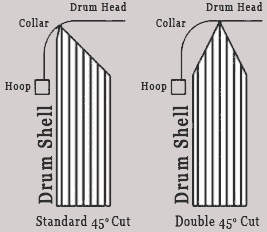
The bearing edge is located on the top and bottom of the drum shell. This is the point where the drum head actually comes in contact with the shell.
There are a few basic types of bearing edge cuts, they are 30o, 45o, double 45o, and rounded. Here are the differences in each cut…
- 30o: This cut has the least drastic edge and can rest in the collar of the drum head. This can cause unwanted vibration and overtones due to the fact that the edge is not touching the flat part of the drum head. This also does not allow the drum head to lay truly flat on the drum. I generally do not like this cut because of the problems which are inherent to it.
- 45o: Obviously a more drastic cut, yet many of the same problems persist because this tends to rest in the collar as well.
- Double 45o’s: This cut creates a very sharp edge which is relocated to the center of the shell plies. This drastically improves performance because the bearing edge contacts the drum head on the flat part of the drum head and moves it away from the collar. The result is a more precise sound which is much easier to tune. This narrow ridge allows the head and shell to resonate freely which produces a much wider range of tones and a longer sustain.
- Rounded: This also moves the contact point away from the collar of the drum head. The big difference between the rounded and double 45o bearing edge is that the rounded edge results in a much larger contact area between the shell and the head. The result of more of the shell touching the head is a somewhat muted sustain and the tones are much more bottom heavy. This is ideal for larger size drums.
 Reinforcement Hoops: This area of the drum world has a bit of a debate with regard to hoop or not to hoop. Reinforcement hoops are simply a ring or band of wood on the inside of the shell located close to the top and bottom of the shell by the bearing edge. The hoops are generally 6 plies thick and 1 inch wide. They were very common in earlier drum sets because they helped maintain the form of the shell, or we would now say helped keep the shell from going “out of round”.
Reinforcement Hoops: This area of the drum world has a bit of a debate with regard to hoop or not to hoop. Reinforcement hoops are simply a ring or band of wood on the inside of the shell located close to the top and bottom of the shell by the bearing edge. The hoops are generally 6 plies thick and 1 inch wide. They were very common in earlier drum sets because they helped maintain the form of the shell, or we would now say helped keep the shell from going “out of round”.
Modern manufacturers say that the advanced shell building techniques, materials, and glue make the hoops unnecessary. Some purists say they are always necessary. The point I would make is if you are dealing with a thin shell, say 6 ply, the hoops may be something you want to look into. As far as how they affect the sound, I would say it is minimal but there is a difference. Generally the hoops will raise the pitch and increase sustain. This is something you should just play with and see which sound you prefer.

Leave A Reply (2 comments so far)
Gail
M-m… so a rounded bearing edge gives a bit of a muted sustain. One would probably want a bearing edge that’s going to give you the best sound.
Chris
Definitely, although some may argue that is exactly what the rounded edge does. This is characteristic of some of the great old vintage drums, but one of my new kits has rounded edges on the floor toms and it produces a great tone. This is certainly one of those areas where you want to spend time trying out a few different configurations to see what you like best.